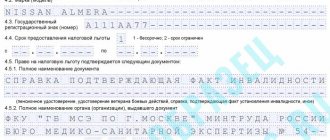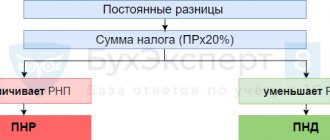In this article we will look at the property tax benefits of an organization. What property does the benefit apply to? The procedure for receiving benefits, where to apply.
The object of taxation of the property of organizations is the fixed assets used in the activities of the enterprise on the basis of ownership rights. Land plots and property transferred to organizations with the rights to manage or maintain lease agreements are not subject to taxation. Enterprises that apply special tax regimes are exempt from paying tax.
Benefits for organizations and categories of fixed assets
When calculating tax, benefits provided by federal legislation or constituent entities of the Federation on the basis of acts issued in the region are applied. The purpose of regional incentives is the need to reduce the tax burden of enterprises of important importance for the region.
Benefits are provided in the form of:
- Tax exemptions. There are 2 types of exemption: all fixed assets of an enterprise or parts thereof used for certain forms of activity.
- Reduction of the rate established for a certain year. For a number of objects, differentiated rates are applied according to the years of use of the property.
- Reducing the amount of tax.
The right to the benefit must be declared to the Federal Tax Service. The taxpayer is required to submit a declaration indicating the benefit code entitling him to tax exemption. Enterprises with special regimes do not submit declarations. The amounts accrued in the declaration are based on accounting data with the base determined as the average annual cost.
What to do if the region unexpectedly introduced a benefit for movable property from 2022
Submit tax returns correctly Stay up to date with changes and current accounting issues for VAT, income tax, personal income tax, insurance premiums Express course
If your region adopted a movable property benefit during 2018, then, in fact, it was adopted “retroactively.” If you found out about this in the middle of the year, then there is no need to redo the calculation of the advance payment for property tax for previous reporting periods. It will be possible to take into account the benefit for the tax period when submitting the declaration.
If you decide not to redo the calculations taking into account the benefits, then this will not pose any threat during inspections. The overpayment of the advance payment will be taken into account based on the results of the tax period.
An example of how to correctly calculate an advance payment with a benefit and a rate of 1.1%
Condition: average cost of fixed assets 3 -10 depreciation groups for half a year - 50,000,000 rubles, incl. movable property accepted for accounting after January 1, 2013 - 10,000,000 rubles. According to regional law, preferential treatment applies to property from the date of release of which no more than 3 years have passed. The average cost of such property is RUB 2,000,000. The rest of movable property is taxed at a rate of 1.1%. The general tax rate is 2.2%.
Solution:
- the average value of property taxed at a rate of 1.1% is RUB 8,000,000. (RUB 10,000,000 – RUB 2,000,000);
- advance payment at a rate of 1.1% - 22,000 rubles. (RUB 8,000,000 x 1.1% / 4);
- the average value of property taxed at a rate of 2.2% is 40,000,000 rubles. (RUB 50,000,000 – RUB 2,000,000 – RUB 8,000,000);
- advance payment at a rate of 2.2% - 220,000 rubles. (RUB 40,000,000 x 2.2% /4);
- the total payment amount for the six months is RUB 242,000. (RUB 220,000 + RUB 22,000).
Property tax benefit codes: order of reflection in the calculation and declaration
| Benefit code in Calculation | Benefit code in the declaration | Expert commentary |
| Line 130 “Tax benefit code” | Line 160 “Tax benefit code” | In the first part, indicate the benefit code in accordance with Appendix No. 6 to the Procedure for filling out the calculation. For example:
Only when indicating benefit 2012000, fill out the second part of line 130 (160) - the number, paragraph and subparagraph of the article of the regional law that establishes the benefit. For benefits with codes 2012400 and 2012500, do not fill out line 130 (160). |
| Line 160 “Tax benefit code (established in the form of a reduction in the tax rate) | Line 200 “Tax benefit code (established in the form of a reduction in the tax rate) | Fill out according to regional legislation.
If your organization is not one of the taxpayers for whom a benefit in the form of a rate reduction has been established, put a dash in this line. |
| Line 190 “Tax benefit code (in the form of a reduction in the amount of tax payable to the budget)” | Line 240 “Tax benefit code (in the form of a reduction in the amount of tax payable to the budget)” | Fill in only if the law of a subject of the Russian Federation has established a tax benefit for a certain category of taxpayers in the form of a reduction in the amount of tax payable to the budget:
|
Where did benefit code 2010257 go from 2022?
Please note that benefit code 2010257 was used for federal benefits in accordance with clause 25 of Art. 381 Tax Code of the Russian Federation. The federal benefit was valid until January 1, 2022.
From 2022, movable property specified in paragraph 25 of Art. 381 of the Tax Code of the Russian Federation, is exempt from property tax only if regional legislation provides for this benefit. Thus, benefit code 2010257 is no longer used (letter of the Federal Tax Service of Russia dated March 14, 2018 No. BS-4-21 / [email protected] ). Instead, for the benefit for movable property registered after January 1, 2013, code 2012000 is used.
Also in connection with the transfer of benefits from the federal to the regions and under clause 21 of Art. 381 of the Tax Code of the Russian Federation it is impossible to use the following codes in 2022:
- 2010337 - in relation to newly commissioned facilities with high energy efficiency, in accordance with the List from the Appendix to the Decree of the Government of the Russian Federation of June 17, 2015 No. 600;
- 2010338 - in relation to newly commissioned facilities with a high energy efficiency class, in accordance with the List from the Appendix to the Decree of the Government of the Russian Federation dated December 31, 2009 No. 1222.
Organizational property tax benefits for enterprises of various types of activities
The vast majority of benefits are provided at the federal level.
| Recipient of exemption | Peculiarities |
| Religious organizations | By property for intended purpose |
| The association of disabled people with the number of persons with disabilities is at least 80% | For property used to conduct statutory activities |
| Penal institutions | For property used in activities |
| Scientific activity | Facilities of enterprises recognized at the state level as scientific centers are not taxed. |
| Cultural activities | Objects classified as cultural heritage are not taxed. |
| Medical activities | Property of prosthetic and orthopedic organizations |
Fixed assets classified in the first and second depreciation groups are not subject to taxation.
Property tax
This type of tax burden falls within the powers of regional authorities. The general procedure for accrual and transfer is regulated at the federal level by Chapter 30 of the Tax Code.
The calculation features and reporting rules for a particular region are determined by local regulations.
Definition of taxpayers
According to the laws, the following categories of legal entities are recognized as property tax payers:
- Russian enterprises with taxable property on their balance sheet;
- Foreign companies with property in the Russian Federation.
The law provides for the provision of benefits to certain categories of organizations. First of all, we are talking about companies operating under special tax regimes (for example, legal entities that participated in the organization of the 2014 Olympic or Paralympic Games).
Preferential categories
A number of enterprises with a special status, due to the type of activity they carry out, are provided with property benefits.
Such legal entities include:
- Enterprises of the special economic zone;
- Pharmaceutical manufacturers;
- Religious organizations.
Other companies can receive an exemption from corporate property tax based on tax benefit code 2010257.
Methods for filing a declaration with a claimed benefit
The declaration is submitted to the Federal Tax Service at the place of registration of the organization or location of the property. Personal submission of the document is allowed, by post, through the information center and the government services website. Enterprises with more than 100 employees or newly registered ones submit reports electronically. The taxpayer independently determines the tax base, distributes the cost at various rates, and reflects the data in the declaration.
The most efficient way to submit a declaration is through transmission through an operator or government services website. The disadvantage of the electronic form is the additional costs of paying the operator or obtaining an electronic signature. The least expensive is to submit a declaration with personal participation, which requires considerable time to complete. Mailing is a time-consuming method of submission, but is suitable for those who do not have the software. The organization can choose which of the costs suits it best.
Tax benefit code 2010257 does not apply
The tax benefit cannot be applied to fixed assets that are not included in the first and second depreciation groups. When calculating the average annual value of property for 2016 -2017. The cost of operating systems included in groups 3-10 is taken into account.
Also, when calculating the average annual value of property, the following are not taken into account:
- fixed assets having a residual value and accepted for accounting before January 1, 2013;
- non-depreciated fixed assets accepted for accounting by an organization in the period 2013-2014 as a result of the liquidation or reorganization of a legal entity.
Application of benefits 2010257 2012000 2012400
Since 2015, movable property objects produced and registered since 2013 are not included in the tax base. Movable property refers to the transport equipment of an enterprise. The benefit does not apply to incompletely depreciated objects received into the ownership of enterprises after reorganization, liquidation or from interdependent persons. This type of benefit is accompanied by an indication of code 2010257 in the declaration.
Regional legislation may provide certain organizations with a reduced rate or other types of benefits (clause 2 of Article 372 of the Tax Code of the Russian Federation). Based on regional benefits, the following codes are used to declare tax breaks:
- Code 2012000 for all types of benefits, with the exception of reductions in tax rates or amounts.
- Code 2012400 in the form of a rate reduction.
- Code 2012500 on tax reduction form.
Some tax benefits do not have separate assigned codes. If an organization has the right to a tax reduction or exemption without an established coding, it is necessary to apply 2010257. We recommend that you read the instructions for filling out the declaration.
Depreciation groups of fixed assets 2017-2018: table
According to paragraph 1 of Art. 258 of the Tax Code of the Russian Federation, depending on their useful life, fixed assets are divided into depreciation groups for tax purposes. The classification of fixed assets was approved by government decree No. 1 dated January 1, 2002. Depreciation groups of fixed assets 2017-2018 - we provide a table of examples of fixed assets included in them in our article - are linked to OKOF codes and certain useful lives.
In 2022, the new edition of OKOF OK 013-2014 (SNA 2008) came into force. The use of new codes is facilitated by the comparative table given in the order of Rosstandart dated April 21, 2016 No. 458.
Since 2022, the classifier of fixed assets by depreciation groups has been updated by Decree of the Government of the Russian Federation dated 07/07/2016 No. 640. The innovations affected only those properties that were registered after 01/01/2017. At the same time, the classification of fixed assets by depreciation groups in 2016 will be applied to the property that was put into operation before 01/01/2017.
Directory of depreciation groups of fixed assets 2017-2018
| Group number | Useful life of the OS, years inclusive | Example of fixed assets of the depreciation group in 2017-2018 |
| First depreciation group | 1–2 | Drilling machines |
| Second depreciation group of fixed assets 2017-2018 | Over 2 to 3 | Snow removal machines |
| Third depreciation group of fixed assets 2017-2018 | Over 3 to 5 | Forest industry buildings |
| Fourth depreciation group of fixed assets 2017-2018 | Over 5 to 7 | Overhead power line |
| Fifth depreciation group of fixed assets 2017-2018 | Over 7 to 10 | Thermal main network |
| Over 10 to 15 | Railway transport structures | |
| Over 15 to 20 | Road bridge | |
| Over 20 to 25 | Railway sidings | |
| Over 25 to 30 | Power plants, overpasses and galleries | |
| Over 30 | Ships |
Additional regional benefits in the cities of Moscow and St. Petersburg
The table below shows benefits for Moscow and St. Petersburg.
| City | Recipients | Size |
| Moscow | Scientific, R&D with budget financing of at least 30% of total activities | 1/4 of the tax determined for real estate with cadastral value is paid |
| Premises for medical, educational, scientific activities, located in shopping centers | 1/4 of the tax determined for premises with cadastral value is paid | |
| Enterprises registered as budgetary, state-owned, autonomous | Liberation | |
| Government and government bodies | Liberation | |
| Transport organizations, metro, with the exception of minibuses | Release subject to receipt of security from the city treasury | |
| Organizations storing reagents | Release of property used for storage | |
| Organizations with more than 50% disabled people on the payroll and receiving remuneration of at least 25% | Exemption for property used in activities, with the exception of brokerage, intermediary and the sale of excisable goods | |
| Saint Petersburg | Property of foreign enterprises with activities other than through official representative offices | 0,7 |
| Non-residential real estate of organizations with an area of over 3 thousand square meters, used for commercial purposes, shopping centers, public catering places | 1% when calculating cost based on cadastral valuation | |
| Residential property of enterprises not accounted for as fixed assets | 1% when calculating cost based on cadastral valuation |
According to the legislation of the city of St. Petersburg, exemption from property taxation is provided for:
- Organizations engaged in the production of devices for disabled people.
- Institutions of power and management.
- Housing cooperatives, residential complexes, homeowners' associations, consolidated property of apartment buildings and companies financed from the budget.
- Buildings intended for religious needs.
- Gardening partnerships.
- Enterprises operating in the fields of science according to the list, the socio-cultural sphere, emergency rescue work and others.
As part of the declaration, documents are submitted confirming the benefit, if the right is not an unconditional norm, arising from the scope of the enterprise’s activities.
What property is not taxed?
In a number of cases, property objects are not subject to tax, namely when such property is excluded from the list of objects of taxation, as well as when the owner of the property is granted the right to a tax benefit. Let's consider each of the above cases in more detail.
Property is excluded from the list of taxable objects
Based on the provisions of the Tax Code (Article 374, paragraph 4), the following are excluded from the list of property objects subject to property tax:
- plots of land, water and natural resource facilities;
- property (both movable and immovable) that is on the balance sheet of the structures of the Ministry of Internal Affairs, the criminal correctional system, the prosecutor's office and other law enforcement agencies;
- property included in the state list of cultural heritage;
- all fixed assets of І and ІІ depreciation groups;
- nuclear service water vessels (icebreakers, nuclear-powered ships), as well as vessels registered in the RMRS (Russian International Register of Ships);
- space objects and nuclear installations.
Preferential property
The provisions of the Tax Code and other current legislative acts provide for the procedure for providing benefits for paying property tax. According to the documents, the benefits are of an industry and social nature, and therefore 100% discounts on tax payments are provided to organizations in the medical, scientific, religious spheres, as well as organizations of the disabled.
| No. | Who gets the benefit? | Description |
| 1 | Prosthetic and orthopedic enterprises | Property owned by enterprises that manufacture orthopedic and prosthetic products is not subject to taxation, namely: · means used to compensate for persistent disabilities (prostheses of the upper and lower extremities); · rehabilitation devices (bandages, corsets, splints, reclinators); · orthopedic shoes and insoles. |
| 2 | Scientific centers | If a scientific center has state status (based on the Decree of the Government of the Russian Federation), its property is not subject to tax. A similar rule applies to universities, provided that the educational institution has experienced equipment, and the institution’s research results are recognized internationally. |
| 3 | Law firms and legal organizations | All organizations with the status of legal entities can use a 100% exemption on property tax. An exception is chambers of lawyers belonging to the category of non-profit organizations. |
| 4 | Institutions of the criminal correctional system | The benefit applies to the property of criminal correctional authorities only if the property is used to carry out the main functions of such an institution. |
| 5 | Organizations of disabled people | The property of organizations of disabled people is not subject to taxation if: · the organization was created by disabled people: · at least 80% of the organization’s members are disabled (members of their families); · The main goal of the organization is to represent and protect the interests of people with disabilities. Also, the property of legal entities whose 100% of the authorized capital consists of contributions from public organizations of disabled people is not taxed. However, the benefit does not apply to property: · used for the manufacture and/or sale of excisable goods; · brokerage companies and intermediary organizations. |
| 6 | Religious organizations | The property of organizations registered as a legal entity and in the form of a religious association of citizens on a voluntary basis is not taxed. |
| 7 | Pharmaceutical companies | If the main activity of an organization is the manufacture and sale of pharmaceutical products, the property of such a company is not subject to tax. It is important to fulfill the following conditions: · the company has a license to operate; · in case of other activities (except pharmaceutical), the company maintains separate accounting. |
Real estate of organizations – “special regime”
The right to exemption from property tax also depends on the tax regime used by the legal entity. In particular, within the framework of the provisions of the Tax Code, individual entrepreneur organizations on the simplified tax system, UTII, Unified Agricultural Tax and patent are not recognized as tax payers.
Additional opportunities provided to enterprises by regions
Regional laws provide benefits to support certain types of activities and reduce the burden on key enterprises. The benefits mainly include the following preferences:
- Enterprises financed by public funds.
- Institutions of power and management.
- Organizations conducting socially significant activities - medical, educational, sports.
- Enterprises containing objects of special significance.
Additional opportunities are provided to organizations that employ the labor of disabled people participating in investment projects.
Taxation of real estate in accounting for special regimes
Enterprises, mainly small businesses, can use one of the special systems for accounting - Unified Agricultural Tax, STS, UTII. The property of enterprises is not subject to tax. The exception is real estate of organizations under simplified and imputed regimes, the value of which is determined by the cadastre.
Objects of regional significance include: administrative buildings, shopping complexes that are intended or used for trading, providing services, catering, and locating offices.
The list of objects is established annually by the regional authorities with mandatory publication. Regions independently determine the area of the object to be calculated according to the cadastral value. The remaining property of organizations under special regimes is not subject to taxation.
Benefit for movable property: before and after 2018
| In 2022 | From January 1, 2022 |
| All organizations have a benefit for movable fixed assets of 3 - 10 depreciation groups registered after January 1, 2013. They were taxed only if received as a result of the reorganization or liquidation of organizations, as well as from an interdependent person (clause 25 of Article 381 of the Tax Code of the Russian Federation). | According to the general rules, all movable fixed assets that belong to 3 to 10 depreciation groups are taxed. These are, for example, cars, medical furniture, hairdressing chairs. Movable fixed assets are not taxed only if a constituent entity of the Russian Federation has adopted a law establishing a corresponding benefit. Regions that decide not to extend the exemption from property tax on movable fixed assets have the right to set a tax rate that does not exceed this maximum. |
What is considered movable property? – The Federal Tax Service of Russia recommends that you be guided by the letter of the Ministry of Industry and Trade of Russia dated March 23, 2018 No. OV-17590/12
Since 2022, regions have been operating under one of the following options (Federal Law No. 335-FZ dated November 27, 2017):
- exempt movable property from property tax (subject to certain conditions);
- a preferential rate is introduced for all movable property (maximum - 1.1%);
- introduce a combination of these two rules (as in the example given later in the article).
Regions may be among the “silent ones” - then the general procedure applies for the company: movable fixed assets included in depreciation groups 3 to 10, registered after January 1, 2013, are taxed at a rate of 1.1%. There is one exception - for Crimea and Sevastopol the rate is 1%.
Reflection of used benefit codes in reporting
When generating reports for each type of benefit, a separate sheet of Section 2 is presented. Data on taxation by rates, location, and benefit codes are presented separately. The data is indicated in the reporting based on the results of each period. If there are no benefits, lines 160, 170, 180, 200, 250 of the declaration are not completed. On line 160, organizations fill out only the first part of the line, except in cases where they have benefits code 2012000. Read also the article: → “Tax reporting for individual entrepreneurs in 2022”
A separate section 3 is intended to indicate property calculated according to the cadastre. The number of sheets in the section must be equal to the number of objects. If there are benefits, organizations fill out lines 070, 120 and 130.
How the code was used until 2022
Even if the company had preferential property, it filed an annual declaration. If regional legislation established reporting periods, calculations for advances were also presented. These documents reflected tax exemption.
Identifier 2010257 was entered in line No. 130 of the second section of the advance payment sheet and line No. 160 of the second section of the company’s property tax declaration.
The lines consist of 2 parts. Code 2010257 was entered into the first as a tax benefit adopted at the national level (the second was left blank).




